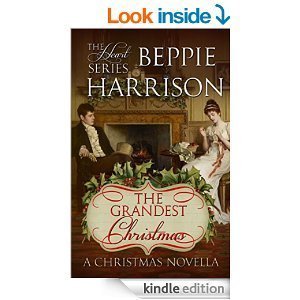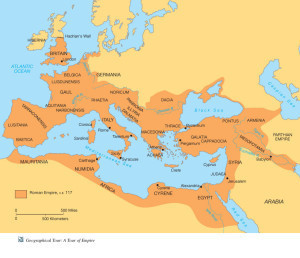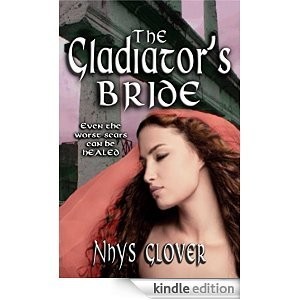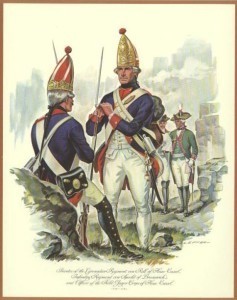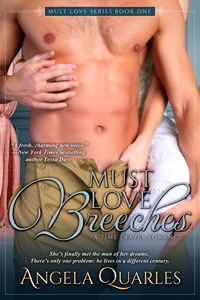L.B. Joramo's Blog, page 3
November 19, 2014
Beppie Harrison and Ireland
Hi, everyone! I’m thrilled and honored to have historical fictional author Beppie Harrison talking about her muse, Ireland. Oh, how I’ve always wanted to go there myself. One of these days. But in the meantime I get to read Beppie’s post about why she picked Ireland and why she’s continued to write about it. Yay! Oh, by the way, I won’t be posting next week, so I’d like to wish everyone a little early a happy Thanksgiving!!! I feel so very blessed to have so many authors sharing with me. Thank you, everyone! So without further ado, here is Beppie and some music to enjoy while you read!
I fell in love at once with Ireland, at the same time ancient beyond human memory and bustling in the 21st century with two nations bumping shoulders on the same small island. When I was at university I was intrigued with the place, but ten years in London during The Troubles put me off entirely, and it wasn’t until we came to the States that the attraction in my blood bubbled up again.
So why has that been the place where I’ve launched my fictional universe? 
Well, it’s green. A deep soul-satisfying green. Unfortunately, green is also what you get when it rains a whole lot, and Ireland, on the western edge of the European landmass certainly picks up its share of moisture sweeping eastward across the Atlantic. As a visitor, I have to be honest and admit that Ireland is much more lovable in the sunshine, but when you live there and a mac (raincoat) and umbrella are part of your basic equipment life goes on swirling around you rain or no rain. But raining or not, you still get to appreciate the green!
Ireland is compact. Nowhere is that far from anywhere else—not at least when you have the North American sense of distance in your bones. Take this lovely picture here: 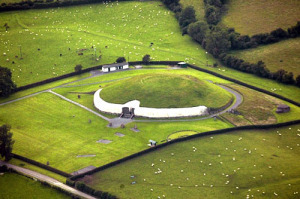
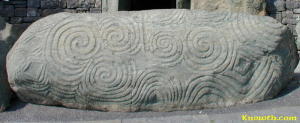 This is from outside the passage tomb at Knowth, near New Grange—the river valley that was the cradle of Irish civilization. This complex is dated from Neolithic times. But if you look at the view (very green, very Irish) you can see a hill that looks crowned with trees: that’s the Hill of Tara, the political and spiritual center of Celtic Ireland and the seat of the High Kings from the 11th century.
This is from outside the passage tomb at Knowth, near New Grange—the river valley that was the cradle of Irish civilization. This complex is dated from Neolithic times. But if you look at the view (very green, very Irish) you can see a hill that looks crowned with trees: that’s the Hill of Tara, the political and spiritual center of Celtic Ireland and the seat of the High Kings from the 11th century.
 The views from there over the Boyne Valley, which stretches across the rich agricultural center of the country, are spectacular. Not far from either is Kells, an undistinguished town with a most distinguished history: it was here in 806 that the monks from Iona fled from the Vikings, and it might well have been here that the matchless Book of Kells, the most richly decorated of Ireland’s medieval illuminated manuscripts, was completed.
The views from there over the Boyne Valley, which stretches across the rich agricultural center of the country, are spectacular. Not far from either is Kells, an undistinguished town with a most distinguished history: it was here in 806 that the monks from Iona fled from the Vikings, and it might well have been here that the matchless Book of Kells, the most richly decorated of Ireland’s medieval illuminated manuscripts, was completed.
Ireland’s long history is an ordinary part of today’s Irishmen and women’s lives. In the market town of Trim—not far from the Hill of Tara or Dublin—you can walk home with your groceries past the Norman Trim Castle, built in the 12th century by Hugh de Lacy, a Norman knight. There’s a nice 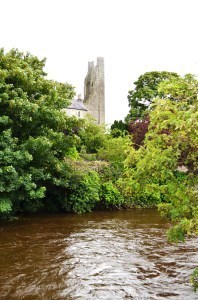 fragment of a medieval church rearing into the sky across the river.
fragment of a medieval church rearing into the sky across the river.
But I think what I like best are Irish people. They are matter-of-fact (and talkative!) now and so they seem to have always been. I ran across a wonderful little book called The Last of the Name, by Seárlas (the English called him Charles) MeGlinchey (the Blackstaff Press, Belfast, 1985), who lived his more than 90 years of life in Donegal, the narrow northwestern edge of the Republic of Ireland, pinned between the pounding Atlantic and the border of Northern Ireland. His story was written down almost 70 years ago by the village schoolteacher. Here’s what he has to say about the emigration to America, from the Irish side:
“It took the ship seven weeks and three days to cross over. The sailing vessels would have to take down sails is a storm got up, and they would often be blown back in one day what they went forward in three days. The vessel had provisions of some kind on board, but everyone took a supply of oaten bread as well with them. The whole townland would be baking and hardening oaten bread for whoever was going away. They were baking for a fortnight beforehand. The bread would be hardened two or three times till you could walk on it. All the bread was packed in a small barrel that the coopers made for the purpose, and everyone going to America had his barrel. They used to get a batáilte [armful] of straw at Derry quay and a bag of biscuits for a shilling. . . the straw was for sleeping on during the voyage.”
At least they were sent off with care and good wishes!
Please check out Beppie’s latest release The Grandest Christmas . . .
*The music is by Adrian von Zielgar who I’m fairly certain is my newest favorite composer. Isn’t her music wonderful?
November 12, 2014
E.E. Burke and The Bloody Benders
OOOOO, today is such a good one! I have as my guest E. E. Burke sharing her latest research into a serial killing frontier family. I got chills. I love getting chills! Oh! and E. E. is giving away five copies of her book on her website. Please stop there for your chance to win! www.eeburke.com Here’s some music to enjoy while you peruse! And now here’s E. E. Burke!
Before Little House on the Prairie, there was The Bloody Benders…
The peaceful Kansas prairie made famous by Laura Ingalls Wilder saw a series of murders in the mid-nineteenth century that rival any killing spree since for pure viciousness.
Here are the facts, such as can be determined…
Between 1871 and early 1873, more than a dozen men traveling through southeastern Kansas vanished without a trace. At that time, the area was still considered a wild frontier, plagued by outlaws and unhappy Natives. The missing men were presumed victims of one or other since they’d last been seen headed west on the Osage Trail.
The first few disappearances didn’t raise an alarm, as it wasn’t all that uncommon for some tragedy to befall a lone traveler. However, as time passed and the number of disappearances increased, surrounding communities became alarmed.
One of the missing men, Dr. William York, was related to a well-known Kansas senator and a wartime hero, who went to search for their missing brother. The colonel discovered that the doctor  had stopped at a store and wayside inn offering meals and a “safe” resting place for travelers headed west.
had stopped at a store and wayside inn offering meals and a “safe” resting place for travelers headed west.
A German immigrant, John Bender, and his wife, along with a grown daughter and son ran the inn. Pa Bender was a hulking man, over six feet tall with piercing black eyes under bushy eyebrows. He and Ma, a heavyset, unfriendly matron, spoke with such guttural accents few could understand them.
In contrast, John Bender Jr. was slender and attractive, and spoke English fluently with a slight German accent. However, he was prone to laughing aimlessly, which led many in the nei ghboring community to consider him a half-wit.
ghboring community to consider him a half-wit.
Kate was the friendliest of the bunch. She spoke good English and had cultivated social skills. The petite auburn-haired beauty was a self-proclaimed healer and psychic. She gave lectures on spiritualism and conducted séances. In some of her lectures, she advocated free love andjustification for murder. Although her friendly manner and social skills earned her popularity (especially with men), her views weren’t so popular. Some of the locals began to call her “satanic.”
 By the time Dr. York’s brother showed up at the Bender’s doorstep, rumors were swirling. Ma admitted the doctor had stopped there for dinner, but indicated he’d left and proposed he’d run into problems with Indians. Kate even offered to conduct a séance to help him. The remaining York brothers were suspicious, but they had no proof of the Benders’ wrongdoing.
By the time Dr. York’s brother showed up at the Bender’s doorstep, rumors were swirling. Ma admitted the doctor had stopped there for dinner, but indicated he’d left and proposed he’d run into problems with Indians. Kate even offered to conduct a séance to help him. The remaining York brothers were suspicious, but they had no proof of the Benders’ wrongdoing.
The Osage Township called a community meeting at a schoolhouse, to discuss the troubling situation and agreed to search farms and homes in the area. The two Bender men attended that meeting.
Several days later, their inn was found abandoned. Upon searching, authorities found the cabin empty of food, clothing and personal possessions. They were also met with a terrible smell. A trap door was discovered, and beneath the cabin, in a six-foot deep cellar, they found the source of the stench—clotted blood.
A frantic search began. The search party lifted the house off its moorings and tore into the cellar, but didn’t find bodies there. Moving into the field and orchard, they noticed the site of a freshly stirred depression and found the first body—Dr. William York—buried head downward with his feet barely covered. His skull had been crushed and his throat cut from ear to ear.
The digging continued and nine more bodies were uncovered, along with dismembered body parts. All of the men had their skulls bashed in and their throats slit. The corpses of a man and a little girl were found together, and it appeared she might’ve been buried alive. Ironically, it was the disappearance of this father and daughter that had sent the doctor off on his quest. The site was christened “Hell’s Half-Acre.”
Eventually, it even got its own historical marker!
Bit by bit, the story was pieced together into an awful picture of what happened to these hapless travelers. Visitors were invited in and seated at a table with their backs to a large wagon canvas, separating the public area from the family’s private quarters.
Kate would charm the men, flirting or revealing her psychic “gifts.” Pa Bender, hiding behind the canvas, would strike the distracted guest with a large hammer, bashing his skull. The women would rifle the body for money, then push the hapless  fellow through the trap door into the cellar, where Kate or her mother would slit his throat.
fellow through the trap door into the cellar, where Kate or her mother would slit his throat.
During the night, the victim would be buried in the garden or orchard behind the house. Neighbors reported having seen the old man out plowing by moonlight, but attributed it to his eccentricities.
By the time the grisly murders were discovered, the Benders had skedaddled. Their abandoned wagon was found in a nearby community. Senator York offered a $1,000 reward for their capture and the governor of Kansas doubled it. Word of the gruesome murders spread fast and thousands of people flocked to the site, including newspaper reporters from as far away as Chicago. The visitors removed souvenirs, including bricks from the bloody cellar and even boards from the cabin’s walls. Pretty soon, nothing was left but the hole where the basement had been.
soon, nothing was left but the hole where the basement had been.
As for what happened to the Benders, that is the stuff of legend.
The author, Laura Ingalls Wilder, referenced the murders in speeches she made over the years. She said she had at one time visited the inn, and her father, “Pa Ingalls” had participated in the vigilante hunt for the killers. Reportedly he told her, “They will never be found.” Frontier justice may have been served, but the records don’t reveal the fate of the serial killers.
Later, curiosity seekers visiting the site would report seeing apparitions they surmised were the ghosts of victims, seeking revenge. Some thought it might be Kate’s ghost, doomed to wander the place where she’d committed the atrocities.
This grisly crime is woven into my latest novel, A Dangerous Passion, as are other historical events in Kansas and railroad history. For more information about the book and series, check out my website at www.eeburke.com. You can also pre-order the eBook through Amazon, http://amzn.to/1wso3IG
Sources: Kathy Weiser, Legends of America; The Benders of Kansas, John Towner James, Kan-Okla Publishing, Wichita, KS, 1913, reprinted 1995. Other links on the Bloody Benders:
The Bloody Benders: Legends of Kansas
http://www.legendsofamerica.com/ks-benders.html
Keepers of the Devil’s Inn
http://www.leatherockhotel.com/BloodyBenders.htm
Kansapedia, Kansas Historical Society
http://www.kshs.org/kansapedia/bender-knife/10106
There is even a Facebook page for a new movie!
https://www.facebook.com/pages/The-Bloody-Benders/338424867050
E.E. Burke writes sexy, suspenseful historical romance set in the American west. Her latest series, Steam! Romance and Rails, includes Passion’s Prize, Her Bodyguard and A Dangerous Passion. Her writing has earned accolades in regional and national contests, including the prestigious  Golden Heart®.
Golden Heart®.
Over the years, she’s been a disc jockey, a journalist and an advertising executive, before finally getting around to pursuing her dream of writing novels. Her stories are as deeply rooted in American soil as her family, which she can trace back to the earliest colonists and through both sides of the Mason-Dixon line. She lives in Kansas City with her husband and three daughters, the greatest inspiration of all.
Praise for E.E. Burke’s historical romances:
“I thoroughly enjoy E. E. Burke’s historical romances. Her portrayal of strong, realistic, well-defined characters and meticulous research transports readers back to the American West of old.”
~ Jill Marie Landis, New York Times bestselling author
“E.E. Burke understands the heart of romance, and delivers it!”
~ Maggie Shayne, New York Times bestselling author
Contact the Author
www.facebook.com/AuthorEEBurke
www.twitter.com/author_eeburke
November 5, 2014
Collette Cameron and the Sandwich
Hello, everyone! I’m thrilled to have historical romance author Collette Cameron back! Today, she’s talking about the Fourth Earl of Sandwich, John Montague. As a military historian, I have a wee bit of a different take on him, but I’ll save that for another time. Here’s some music to enjoy while you read!
COVER REVEAL-TRIUMPH AND TREASURE
and
THE EARL OF SANDWICH MAKES ME GAG
By Collette Cameron
As any historical author can tell you, we really research all those little details that make for authentic reading. Triumph and Treasure, the first book in my Highland Heather Romancing the Scots Series, is releasing in December 2014 had me snooping around for information on sandwiches.
Not because I planned on having my characters eat any, but because I wanted to use the word in another context.
Since the story is set in the early 1800s, I wanted to make sure John Montague, 4th Earl of Sandwich had lived prior to that time. A most unsavory and unpopular chap, he’s credited for the word sandwich as it refers to two bread-like pieces enclosing a filling of some sort.
Conveniently, he was born in 1718, which suited my purposes just fine.
For those of you who don’t know the story, legend has it that around 1762 the 4th Earl of Sandwich was so fond of playing cards—interpretation, gambling—he didn’t want to leave the table to eat, nor have food brought to him which required a fork and knife. Or, eat the meal with his fingers.
was so fond of playing cards—interpretation, gambling—he didn’t want to leave the table to eat, nor have food brought to him which required a fork and knife. Or, eat the meal with his fingers.
He ordered beef between two pieces of bread be brought to him, which not only allowed his game to continue, but kept grease from his cards.
Other sources insist he actually began the custom of eating meat and bread, or cheese and bread, as sandwiches were called prior to the earl’s “invention,” while working at his desk as the chief admiral of the English Navy.
In any event, the story goes that people started ordering their food, “The same as Sandwich,” and thus the name stuck.
I almost wish I hadn’t looked up the man’s history, since every time I want to eat a sandwich now, I recall the debauched lecher and seducer of virgins for whom my meal is name after. On the other  hand, as a fan of tea parties and the dainty little bits of deliciousness served for them, I might be persuaded to overlook the word’s origin and just enjoy my food.
hand, as a fan of tea parties and the dainty little bits of deliciousness served for them, I might be persuaded to overlook the word’s origin and just enjoy my food.
I have always wondered though, what would have happened if a different lord of the realm had been credited with the invention. We might be eating tweedmouths or portlands.
Today I’m thrilled to share the cover of Triumph and Treasure.
A disillusioned Scottish gentlewoman.
Angelina Ellsworth once believed in love—before she discovered her husband of mere hours was a slave-trader and already married. To avoid the scandal and disgrace, she escapes to her aunt and uncle’s, the Duke and Duchess of Waterford. When Angelina learns she is with child, she vows she’ll never trust a man again.
A privileged English lord.
Flynn, Earl of Luxmoore, led an enchanted life until his father committed suicide after losing everything to Waterford in a wager. Stripped of all but his title, Flynn is thrust into the role of marquis as well as provider for his disabled sister and invalid mother. Unable to pay his father’s astronomical gambling loss, Flynn must choose between social or financial ruin.
When the duke suggests he’ll forgive the debt if Flynn marries his niece, Flynn accepts the duke’s proposal. Reluctant to wed a stranger, but willing to do anything to protect her babe and escape the clutches of the madman who still pursues her, Angelina agrees to the union. Can Flynn and Angelina find happiness and love in a marriage neither wanted, or is the chasm between them insurmountable?
ENJOY AN EXCERPT FROM TRIUMPH AND TREASURE.
“Moll and Lasses . . . for molasses?” Angelina’s lips twitched in amusement.
“Exactly so.” Lord Bretheridge regarded Lady Francesca affectionately. “She named my horse Kane.”
“She didn’t.” Angelina grinned unabashedly. “Truly?”
He winked and nodded. “Indeed.”
“Have you other pets?” She made a pretense of scanning the grounds. “A cat named Sugar or Sweetie perhaps?”
Angelina patted Sir Freckleton’s mottled head. “I’m surprised he’s not named Sir Bon Bon.”
“Mrs. Thorne, are you poking fun at my pets?” The marquis pressed an arm across his broad chest in mock offense.
“Most assuredly, my lord,” she quipped, before she could stop herself.
Not prudent. He might get the wrong impression about her interest in him. Not that she was interested, because she wasn’t. However, if she was ever to become fascinated in a man again . . .
For pity’s sake, Angelina. Do stop your mental prattling!
She purposely changed the subject to something far safer. “Now, about those roses . . .”
They’d dawdled long enough. Angelina wasn’t altogether comfortable with this light-hearted bantering. It was too personal, too intimate, and after what Charles put her through, she never wanted to be intimate, physically or emotionally, with a man again.
Lord Bretheridge didn’t offer her his arm as they headed for the conservatory, for which she was grateful. She’d no desire for her traitorous body to respond to him. She was sure it would. Maybe there was something wrong with her. That’s why she was attracted to handsome men who turned her into to quivering plum pudding whenever they touched her.
Well, two men could at least, though everything beyond Charles’s kisses proved wholly disappointing.
New rule, avoid attractive men. And ones causing curious quivers in unmentionable places.
Resources:
http://en.wikipedia.org/wiki/Sandwich
http://www.open-sandwich.co.uk/town_history/sandwich_origin.htm
http://wordinfo.info/unit/3058/ip:1/il:S
All images except Triumph and Treasure are courtesy of Wikimedia Commons
October 29, 2014
Happy Halloween!
Halloween is my all-time favorite holiday. I love things a little dark and mysterious, which segues into my still favorite poet, Edgar Allan Poe (although, Dickinson sometimes pushes him around). Here are two poems I recite to my poor son this time of year . . .
And here’s a nice documentary about the history of Halloween . . .
Do you have a favorite Halloween tradition? Read creepy poetry? Decorate your house? Wear a favorite costume?
Oh, and Happy Halloween!
October 23, 2014
Nhys Glover and one more tool for historical authors
Hi, all! I’m super excited to have author Nhys Glover here today, talking about Stanford University’s Orbis Project. For those writers obsessed with the Roman Empire this is for you! Since I love learning about all times, I love the Orbis Project too! Here’s some music to enjoy while you read through. And now here’s Nhys!
BLOG POST: EXPLORING THE ANCIENT ROMAN EMPIRE WITH ORBIS
When I wrote my first historical romance set in Ancient Rome I spent an inordinate amount of time trying to calculate how long it would take to get from Point A to Point B, factoring in the average pace of horses over long distance, type of vehicles used, and geographical factors like mountains, swamps etc. Sometimes I’d get so frustrated that I’d just gloss over those little details with ‘a weeks or more later’, or something equally as vague. Then when I was researching my second Roman Historical some years later I came across Stanford University’s Orbis Project. (Note the vagueness in the timing there, too? That’s not from ignorance but because I wrote that first book, Liquid Fire, over about twenty years.)
Imagine if you wanted to take a holiday (vacation for you Americans) somewhere in the world, but you weren’t sure where or how best to get there. Imagine sticking a pin in the map and then entering your home address and then your hypothetical destination. Sure, you can do that on a Route Finder. But does it also give you different methods of travel and the different lengths of time they will take at different times of the year? And even more importantly, does it give you the cost for each different type of journey? None that I’ve been able to find does all that in one place.
But Orbis does it all and more. Over four novels I’ve used Orbis to plot journeys from Rome to Pompeii, (it was faster to do it by sea I discovered, though in my first novel my protagonists did it by carriage because I didn’t know any better,) and on to Carthage. From Northern Africanus my protagonists took ship for Gaul and onward to Britannia. Or they travelled from Rome to Magna Germania or Rhodus and Ephesus. Every journey I was able to lay out in detail, right down to the time between one port or town and the next on the trip.
Now obviously knowing all this information doesn’t mean using all this information, but it’s amazing how wonderfully useful it is when plotting a chase across the Empire when there are several different groups, some of whom depend on merchant ships for travel and others on much faster military vessels. I could create separate timelines for each group and work out how best they could intersect at strategic moments. I couldn’t have even contemplated that without Orbis.
So how do you get to access this miraculous tool? Does it cost you a fortune? Is it restricted to researchers or academics? You can access it here http://orbis.stanford.edu/orbis2012/ , (just click on the map to get started,) it costs you nothing to use, and any old Joe Bloggs can use it. All it takes is time to get your head around it, like any new app. That’s why, when the new Orbis version came in, (I’ve directed you to the older version,) I was relieved to see the old one was still available. I had enough time learning how to negotiate the first version, I had no desire to upgrade for the bells and whistles of the new version. (A bit like Windows and Word upgrades. Do we really need them? But that’s my pet peeve and irrelevant here.)
If you’ve ever imagined life back in Roman times, then take a cyber-journey there, courtesy of Orbis. To give it a bit of colour, Google some of the odd place names and see what comes up. And if you get really hooked, you might decide to try writing a novel about the period yourself. It is, in my opinion, a much underrated era for the romance genre.
And if you don’t want to do the work, you can always read one of my novels. ‘The Gladiator’s Bride’, my latest, is set just outside Rome and then in Ancient Britannia. I used Orbis to plot the mission to save the heroines in the latter part of the book. It’s available for pre-release order now. Or if I’ve whetted your appetite for all things Roman and you want to get started right now, and don’t mind a bit of sizzle in your romance, try ‘The Barbarian’s Mistress’ and see just how I used Orbis for yourself.
Thanks, so much, Nhys! Please click on the image below to find more about Gladiator’s Bride . . .
October 15, 2014
Ashley York shares all about Wikipedia
Hi, all! This week I’m thrilled to have historical fiction writer Ashley York, sharing with us her take of research and Wikipedia! Ashley and I share a common favorite band, and you can listen to it here while you peruse her post. And now . . . here’s Ashley!
So you’re reading something and come across a term you’re unfamiliar with. What do you do? Well, if you’re like many, many people you look it up on Wikipedia. Bingo. That’s what it is! How  could you not have known that. And off you go on your merry way thinking, “It really is true. You do learn something new every day.” STOP!
could you not have known that. And off you go on your merry way thinking, “It really is true. You do learn something new every day.” STOP!
I was in college when computer use blew up. It was everywhere. It couldn’t be avoided. It was in your face! It wasn’t long before the only way you could register for a course was through a computer and with that darn password that expired every 90 days when a semester is 105 – whose poor planning was that? That, my friends, is when the wonder site “Wikipedia” appeared. The professors, such kill joys, said “Do not use Wikipedia.” So we listened (?) but that was many years ago and surely now it’s more reliable or works differently or whatever their aversion to it was must be fixed, right? No!
Wikipedia is a place where, in its own description “almost anyone can access the site [and] can edit almost any of its articles.” They’re not necessarily knowledgeable. They don’t have to prove their credentials. They’re not scrutinized by their peers for assessment or accuracy. They can literally put anything they want to on that site. They pride themselves on their “high openness” and “inclusion of much unacademic content.” What does “unacademic” mean? Not scholarly. What does scholarly mean? Relating to serious academic study. So that term you think you know about now? And can have a knowledgeable discourse with someone about? You may not want to put yourself out as an expert when your own source is Wikipedia. I’m just saying.
Yep, I’m one of those people who might be considered a kill joy. However! I must confess I love Wikipedia, but I ALWAYS check sources.
October 8, 2014
Vicki Batman and the History of M&Ms!!!
I’m thrilled to have Vicki Batman here, talking about, one of my favorite things EVER, M&Ms. Here’s some fun music to enjoy while you read through. And now, here’s Vicki!
Hi, everybody! Usually, Lani invites guests to talk about something historic. I’m like…hmm. What can I do? I walked around and then it hit me—write about M&Ms.
You see, my heroine from Temporarily Employed, Hattie Cooks, loves M&Ms, specifically M&Ms. And the hero, Det. Allan Wellborn, gives them to her when he finds out that is her favorite treat.
Here’s what I found on Wikipedia: Forrest Mars, Sr., son of the founder of the Mars Company Frank C. Mars, copied the idea for the candy in the 1930s during the Spanish Civil War when he saw soldiers eating chocolate pellets called Smarties, with a hard shell of tempered chocolate surrounding the inside, preventing the candies from melting. Mars received a patent for his own process on March 3, 1941. Production began in 1941 in a factory located at 285 Badger Avenue in Clinton Hill, Newark, New Jersey. The two “M’s” represent the names of Forrest E. Mars Sr., the founder of Newark Company, and Bruce Murrie, son of Hershey Chocolate’s president William F. R. Murrie, who had a 20 percent share in the product. The arrangement allowed the candies to be made with Hershey chocolate, as Hershey had control of the rationed chocolate at the time.
Peanut M&M’s were introduced in 1954, but first appeared only in the color tan. They were debuted at the same time as the tagline “Melts in your mouth, not in your hand.” In 1960, M&M’s added the yellow, red, and green colors. Varieties have included these fillings: milk chocolate, dark chocolate, white chocolate, crisped rice, mint chocolate, peanuts, almonds, orange chocolate, coconut, pretzel, wild cherry, cinnamon, raspberry, birthday cake, pumpkin spice, candy corn, cherry cordial, strawberry peanut butter, peppermint, gingerbread, peanut butter, red velvet, carrot cake, dark chocolate peanut, pineapple and vanilla shake.
So I was curious and wondered which varieties I’d tried: Milk, dark, white, crispy rice, mint, peanuts, almonds, pretzel (!!!), wild cherry, birthday cake (eh), dark chocolate peanut. Some of the varieties I’d never heard of. Here’s where you can find out more about M&Ms: http://en.wikipedia.org/wiki/M%26M’s
Like I said, my hero gifts my heroine with the treat. Here’s an excerpt:
Plop! A brown paper bag tied with a balloon tipped inside the open doorway. With a hand pressing on my aching back, I bent over and examined the bag, inscribed with Hattie in black 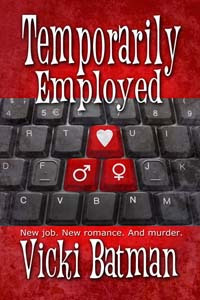 marker.
marker.
“What’s takin’ so long? What are you doin’?” Jenny asked.
“Check this out.”
She joined me. “Wow, a gift! I haven’t seen one of those since the passin’ of dinosaurs. Who gave it to you?”
“I haven’t a clue.”
“Girlfriend—” she nudged me in the side, “—I do believe you have a secret admirer.”
My insides were shouting woohoo. “Who could it be?”
We marveled the floating Mylar flower pot filled with colorful daisies. My finger plucked the string tying the balloon to the bag, causing it to bob and weave. Rare novelties like this should be savored. “I like the balloon. It’s colorful and happy.”
“Why a Get Well balloon? Are you sick with somethin’ I don’t know about?” Her voice dropped to a concerned level. “Do you have some kind of sex disease?”
“No! I’m not sick. You have to fornicate in order to get those diseases and how would I get any if I’m in Nundom?” I nudged my toe against the bag. “It’s cute.”
“Maybe I should shoot a photo for posterity.” She dug her cellphone out of her pocket and captured the Kodak moment. “Smile.”
“Since this hasn’t happened to either of us recently, I think I’ll remember.” I shoved her arm. “And don’t go posting that picture to Facebook.”
“Remember the pot of red tulips last Valentine’s Day?”
As if I needed reminding. What a horrible blind date. I needed to settle a score with my friend Maggie for the huge mistake, undoubtedly one of her rejects. Despite popular belief, not every man looked good in a tuxedo. Most did, but this one hadn’t. “Yeah, but we burned the note ‘cause the guy was creepy.”
“He really was.” She tilted her head. “What are you waitin’ for? If you don’t hurry and open it, I will.”
I picked up the sack and untied the balloon which she took from me. Then, very cautiously, I opened the bag and took a peek. Thank God, no bombs. Crammed inside was a one-pounder package of Peanut M&Ms, my favorite chocolate. Buried underneath, I found a white note card, decorated with a gay, pink heart. I extracted the card and unfolded it with care.
“Hurry up!” she said. “Who’s it from?”
“Hold your horses. I don’t want any more surprises.”
The card read:
Hattie, I’m sorry things were difficult for you yesterday. I would like to try pizza again. Call me. I hope the chocolate’s “restorative and curative powers” will help me.
—Allan
Jenny took the note card and scanned it. “Thoughtful.”
“Yep.”
“Nice.”
“That’s what everyone says.”
“Goin’ to call?”
I grinned. Chocolate and a dinner invite were the ultimate combination. I’d come to the conclusion A. Wellborn was a pretty decent guy and found I’d suffered no serious—only dramatic—side effects from being with him.
My favorite used to be peanut ones then when pretzel appeared-whoa, mama! What’s your favorite variety?
Find this romantic comedy mystery, Temporarily Employed, at:
The Wild Rose Press: http://www.wildrosepublishing.com/maincatalog_v151/index.php?main_page=product_info&products_id=5829
Find Vicki at: http://vickibatman.blogspot.com
Facebook: http://on.fb.me/1ipdLkv
Twitter: https://twitter.com/VickiBatman
Pinterest: http://pinterest.com/vickibatman
Thank you so much, Lani, for having me!!
Aw, thanks so much for being here, Vicki!
October 1, 2014
James Mc Intyre talks about Hessians and mercenaries of the 18th century
I’m so excited to have Jim here! We took a graduate-level class together, and teaches history for many undergraduates now. Actually, he taught back then too! He’s so talented, writing in his spare time an historical book I can’t wait to be released. Here’s some music to enjoy while you read through. And now help me welcome Jim!
What was so Significant about the Hessians? The Meaning of the Use of Mercenaries by the British in the American War of Independence
By
James R. Mc Intyre
It is impossible we should think of submission to a Government that has, with the most wanton barbarity and cruelty, burned our defenseless towns in the midst of winter, excited the savages to massacre our peaceful farmers, instigated our slaves to murder their masters, and is even now bringing foreign mercenaries to deluge our settlements with blood.[1]
These words, written by Benjamin Franklin to Lord Robert Howe in July of 1776 convey a powerful sentiment prevalent among American colonists concerning the British use of contract troops. Franklin continued, asserting that “These atrocious injuries have extinguished every spark of affection for that parent country we once held so dear.”[2] In his condemnation of British actions, Franklin built up to a crescendo of abuses the colonists had suffered at the hands of ministry. The proposed use of mercenaries by the Crown to subdue the revolt stood as the high note in Franklin’s scale. John Adams voiced a similar sentiment in a letter to James Warren earlier that same year. Adams claimed that George II “excluded the Inhabitants of these united colonies from the Protection of his Crown,” and, aided by foreign mercenaries, that the “whole Force of the Kingdom, is to be exerted for our Destruction.”[3]
These two well-known revolutionaries were not the only ones to decry the British government’s use of hired troops to suppress the insurrection of Britain’s thirteen seaboard colonies in North America. For instance, the New Hampshire House of Representatives noted, in June 1776,
the British Ministry, arbitrary and vindictive, are yet determined to reduce by fire and sword, our bleeding country to their own forces have engaged great numbers of foreign mercenaries…to ravage and plunder the sea coast; from all which we may expect the most dismal scenes of distress the ensuing year, unless we exert ourselves by every means and precaution possible.[4]
In like fashion, the members of the New York Convention, writing in July of 1776, attacked the actions of George III on this point in the following language,
He is, at this juncture, transporting large Armies of foreign Mercenaries to complete the works of Death, Desolation, and Tyranny, already begun with circumstances of cruelty and perfidy scarcely paralleled in the most barbarous Ages, and totally unworthy the Head of a civilized Nation. [5]
Clearly, many contemporaries viewed the use of foreign mercenaries as something of a dirty play on the part of the British government and more specifically, King George III.
Numerous historians picked-up on these contemporary perceptions and commented on the use of Hessian troops by the British ministry in putting down the American Rebellion. For Pauline Maier, “George III’s hiring of German soldiers to fight the colonists was cited almost everywhere and seems to have been decisive in alienating large numbers of colonists from the Crown.”[6] For Maier, the Ministry’s decision to employ mercenaries in the suppression of the colonial uprising served as a key factor in driving many to support independence. The following will address the question of the significance of the British employment of German mercenaries in the American War of Independence. Why did the use of mercenaries generate such a virulent reaction form colonists? Secondly, why did the use of German troops, in particular, exacerbate their anger? In order to answer these question, it is first necessary to examine the employment of mercenary by Great Britain troops in the European conflicts of the eighteenth century and how it was perceived. It will then discus the use of these troops in North America.
First and foremost, it must be pointed out that the designation mercenary served as something of a misnomer when applied to the troops raised by the British ministry. The troops raised by Great Britain in the German states of the Holy Roman Empire were more properly referred to as subsidy troops.[7] Therefore, the principalities of Anhalt-Zerbst, Hesse-Kassel, Hesse-Darmstadt, Hesse Hanau, Waldeck, and Brunswick did not simply “sell” their troops to the British government.[8] Instead, they provided troops in return for monetary payment, but just as important, they received
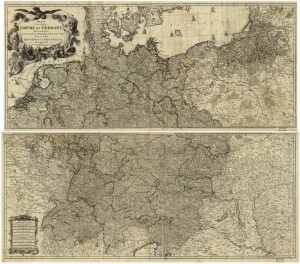
Empire of Germany and its states
a treaty of alliance with Great Britain. This on its own constituted a valuable asset for smaller states squeezed in between larger, expansion-driven kingdoms such as Prussia and France. While they were still part of what historians refer to as the Soldatenhandel or “soldier trade,” the troops supplied by these six states were far from the traditional definition of mercenaries, soldiers who fought purely for financial gain. They were, in fact, serving the foreign policy of their monarch.[9] While the subsidy troops provided several benefits to their own prince, they allowed the Crown the opportunity to mobilize trained troops more rapidly than they could bring their own army, which was often under-strength in peacetime, to a wartime footing.[10]
It is worth noting as well that the American crisis was not the first time the British Crown turned to troops raised in the German states to augment their military forces. They had resorted to similar measures during the Jacobite Rising of 1745 led by Bonnie Prince Charlie.[11] In this case, the Crown had brought a contingent of Hessians over to Scotland to maintain security while British regulars completed the work of suppressing the rebellion. On this occasion, the use of subsidy troops received warm support from British popular opinion.
The preceding undoubtedly raises questions concerning the conduct of the Hessians in Scotland while pacification operations were taking place. Did these troops mistreat the civilian populace? The answer here is an unequivocal no. The eminent eighteenth century military historian Christopher Duffy explored this question in great depth. What he discovered, in fact, demonstrates quite the opposite. The Hessians were compassionate in their treatment of the Highland refugees in the aftermath of the battle of Culloden on April 16, 1746—the engagement that broke the back of the uprising. The restraint shown by the Hessians actually served to highlight the harsh nature of British policy. The hired troops behaved better towards a foreign population to which they had no connection than different members of the same kingdom.[12]
If the Hessians behaved with great restraint in Scotland some three decades previous, why was their proposed use in the American colonies so dreaded? The answer is twofold. First, many of the great thinkers of the Enlightenment possessed a decidedly negative view of the use of subsidy troops, equating it to slavery. As Peter H. Wilson observes, “It was not that the treaties themselves had changed, but rather the attitudes towards them.”[13] While this explanation serves to illuminate the negative reaction Britain’s use of various German contingents elicited in Europe, it sheds no light on the colonial reaction.
Ironically, a key to understanding the colonists’ reaction to the use of mercenaries may be the Scots. According to historian Frank Whitson Fetter, these were the mercenaries many colonists were referring to. Fetter notes that in a draft of the Declaration of Independence submitted for debate by Thomas Jefferson, he referred specifically to Highland Scots. These would be the descendants of many of those who fought at Culloden. In the aftermath of the uprsing, their chieftains had pledged loyalty to the British Crown, and they quickly became a bulwark of support for the government.[14]
The first Highland regiments were raised in the Seven Years’ War, and some saw service in North America. The 42nd regiment or Black Watch earned a particularly valorous record during their service in North America. For many at the time, Highlanders were considered semi-barbarous, and therefore a logical countermeasure in dealing with Native Americans.[15]
However, many ardent supporters of declaring independence were colonists of Lowland Scottish or Scots-Irish descent. A generic mention of “Scots” could potentially alienate them from the cause. Therefore, the designation of Scottish was removed, and generic mercenary remained. Generations have since assumed that the term referred specifically to the German troops then being raised in Europe by representatives of George III.[16]
So the Scots were the mercenaries feared by so many colonists on the eve of independence. They could be seen as mercenaries for the fact that their chieftains sold their support in return for their own political aggrandizement in the realm, or at least that was a hope. In this sense, as well, they 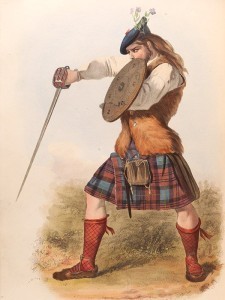 would fit into the growing debate on slavery and human rights. As previously noted, this debate occurred across the Atlantic World, and numerous groups could be categorized as slaves, whether they were Africans toiling in the Caribbean or North Carolina, Hessian subsidy troops, or Scottish clansmen.[17] As Charles Royster notes, the opposition to slavery constituted a powerful motivation for taking up arms against the British Ministry, for “If a generation enslaved itself, it enslaved its posterity, who would never know a different state.” [18] Thus, the vitriolic response to the use of mercenaries sprung from their potential for enslavement of a free people.
would fit into the growing debate on slavery and human rights. As previously noted, this debate occurred across the Atlantic World, and numerous groups could be categorized as slaves, whether they were Africans toiling in the Caribbean or North Carolina, Hessian subsidy troops, or Scottish clansmen.[17] As Charles Royster notes, the opposition to slavery constituted a powerful motivation for taking up arms against the British Ministry, for “If a generation enslaved itself, it enslaved its posterity, who would never know a different state.” [18] Thus, the vitriolic response to the use of mercenaries sprung from their potential for enslavement of a free people.
[1] Benjamin Franklin to Lord Howe, July 21, 1776, quoted in American Archives, Series 5,volume 1, 482-83.
[2] Ibid.
[3] John Adams to James Warren, May 15, 1776, quoted in Letter of the Delegates of the Continental Congress, vol. 3, January 1-May 15, 1776, 678.
[4] Minutes: New Hampshire House of Representatives, June 14, 1776, quoted in Am. Arch., Series 5, vol. 1, 66.
[5] New York Convention quoted in Ibid, 1389.
[6] Pauline Maier, American Scripture, 80.
[7] Several historians have done extensive research in this area. They include Charles W. Ingrao, The Hessian Mercenary State: Ideas, Institutions, and Reform under Frederick II, 1760-1785. Cambridge: Cambridge University Press, 1987.
[8] The two main works to address the use of Hessian auxiliaries by the British in the War of Independence are Edward J. Lowell The Hessians and Other German Auxiliaries of Great Britain in the Revolutionary War. Gansevoort, NY: Corner House Historical Publications, 1997 reprint of 1927 original. More recent, though still dated is Rodney Atwood The Hessians: Mercenaries from Hessen-Kassel in the American Revolution. Cambridge: Cambridge University Press, 1980.
[9] On the Soldtenhandel, see Peter H. Wilson War, State and Society in Wurttemberg, 1677-1793. Cambridge: Cambridge University Press, 1995, 174-78. For a discussion of how the use of subsidy troops effected the policy of Hesse Kassel in particular, see Ingrao The Hessian Mercenary State, 122-163.
[10] On the benefit to the British government, see Atwood, Hessians, 15. For the state of the British Army in peacetime, see J.A. Houlding, Fit for Service The Training of the British Army, 1715-1795.Oxford: Clarendon Press, 1981, 11-13.
[11] Christopher Duffy The ’45: Bonnie Prince Charlie and the Untold Story of the Jacobite Rising. London: Cassell Military, 2003, W.A. Speck The Butcher: The Duke of Cumberland and the Suppression of the ’45. Caernarfon: Welsh Academic Press, 1995, and A.J. Youngson The Prince and the Pretender: Two Views of the ’45. Edinburgh: Mercat Press, 1996.
[12] Christopher Duffy, The Best of Enemies: Germans against Jacobites, 1746. Chicago, IL: the Emperor’s Press, 2013, 132-33. For an excellent discussion of restraint versus atrocity in several different but contemporary contexts, see Wayne E. Lee, Barbarians and Brothers: Anglo-American Warfare, 1500-1865. Oxford: Oxford University Press, 2011. Unfortunately, Lee does not discuss the Jacobite Rebellion.
[13] See Wilson War, State and Society, 75.
[14] Frank Whitson Fetter “Who Were the Foreign Mercenaries of the Declaration of Independence?” in The Pennsylvania Magazine of History and Biography, 104, 4(Oct. 1980) 508-13.
[15] On the Highland units used in American in the French and Indian War, see Stephen Brumwell, Redcoats: The British Soldier and War in the Americas, 1775-1763. Cambridge: Cambridge University Press, 2002, 164-189.
[16] Fetter, “Who Were the Foreign Mercenaries,” 509.
[17] For a thorough discussion of the concept of the Atlantic World and the changing place of slavery in it, see Aaron Fogleman, “The Transformation of the Atlantic World, 1776-1867.” in Atlantic Studies, 6, 1 (April 2009): 5-28.
[18] Royster, Revolutionary People at War, 7.
September 24, 2014
Angela Quarles talks about the Genius of Ada Lovelace
Hi, all! I’m thrilled to have historical fiction author Angela Quarles on my blog, talking about the wonderful woman, Ada Lovelace. Here’s a bit of music while you peruse. And now here’s Angela!
A Brief Look at Mathematician and Visionary Ada Lovelace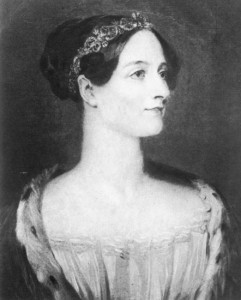
A major secondary character in my debut novel Must Love Breeches is Ada Lovelace, though in the book, she’s not yet married, so she’s known as Ada Byron. Since this blog is geared to history, I thought it apt to share a little bit about this fascinating woman. I purposely picked 1834 as the year my heroine time travels to so she could meet Lady Lovelace when she was still single (and known as Miss Byron).
So, who was she?
She was the only legitimate child of Lord Byron, the famous English poet a former lover called ‘mad, bad, and dangerous to know.’ However, she is famous in her own right, as she’s credited as being the world’s first computer programmer. In fact, the United States Defense Department named their new computer language, unveiled back in 1980, ADA.
Born in 1815, she had a genius for mathematics, and when she first saw Charles Babbage’s Difference Engine, she immediately grasped its implications. Babbage later scrapped that project and began work on the Analytical Engine, which was a mechanical computer that, if it had been completed, would have ushered in the computer age almost 100 years early. We have to remember that back then, computers as a concept weren’t something easily understood, and most just didn’t get it when Babbage showed off his prototype to potential investors. But Ada did. She even saw beyond the number crunching into a more poetical way of speculating on its use:
[The Analytical Engine] might act upon other things besides number, were objects found whose mutual fundamental relations could be expressed by those of the abstract science of operations, and which should be also susceptible of adaptations to the action of the operating notation and mechanism of the engine…
Supposing, for instance, that the fundamental relations of pitched sounds in the science of harmony and of musical composition were susceptible of such expression and adaptations, the engine might compose elaborate and scientific pieces of music of any degree of complexity or extent [http://www.newscientist.com/article/dn22385-ada-lovelace-my-brain-is-more-than-merely-mortal.html]
Wow. Just wow. I mean, seriously, how ahead of her time was she? Unfortunately, her life was rather tragic. Her mother, obsessed that Ada would “catch” Lord Byron’s “madness,” kept her on a very strict educational regimen and pretty much made Ada believe she could become mentally ill. She was also not a very nurturing mother figure. In addition, Ada’s life was cut short at the age of 36 by cancer. In Must Love Breeches, I imagined she had escaped a lot of her mother’s tyranny and successfully fought her cancer and lived longer.
But during her short life, she formed a lifelong friendship with Charles Babbage, who called her the Enchantress of Numbers. In 1842, Babbage gave a lecture in Turin on the Analytical Engine which was written up in French. Ada was asked to translate it into English, and she took it a step further and added her own section called “Notes” which was longer than the original paper. It was in these notes, that she wrote up an algorithm that could run through the engine to compute Bernoulli numbers, which experts have said would have worked if Babbage had completed the mechanical computer. It is for this reason that she’s credited as the world’s first computer programmer.
Want to really understand the power and importance of Lovelace and Babbage’s work? Watch this great video giving the background and also plans to build the Analytical Engine.
Want even more? Here’s a delightful peek at some of the letters she wrote to Michael Faraday.
Ada Lovelace today
Steampunk lovers know her as one of the character’s in William Gibson and Bruce Sterling’s alternate history novel The Difference Engine, where Charles Babbage finishes his invention and the computer age is ushered in much earlier. But she was also totally ‘steampunk’ in her own lifetime– she actually, as a child, tried to invent a steam-powered horse! She had her scientific pen pals send her dead birds so she could measure wing span to body mass. I’m not making this up.
Besides The Difference Engine, she’s also a main character in this novel: Lord Byron’s Novel: The Evening Land (P.S.). I came across this at a library sale, talk about serendipity! It’s an imagined novel of Byron’s but set within two different story frames: one, present day emails of a researcher who has ‘discovered’ this lost novel, and then, ‘notes and letters’ written by Ada about her attempts to recover the novel and hide it from her mother.
She’s a main character of a webcomic by Sydney Padua called 2D Goggles, or The Thrilling Adventures of Lovelace and Babbage. In 2012, they announced the comics will finally be in book form, and just this month said it was close to being done, with a projected release date of April 2015. They also have a Lovelace & Babbage app for the iPad.
Homage to Lady Lovelace through the ages from Tor.com’s artist Scott Brandage
Other Random Facts:
· Lady Lovelace made The Guardian’s list: The Guardian’s Open 20: fighters for internet freedom
· Initially it was reported that Steve Job’s biographer will write Lady Lovelace’s biography next (which I was doing a happy dance about), but then it was reported that it will be about the history of digital information and so she will only be how the book opens.
· In the weird department, she got a giant tunnel boring machine named after her in the UK
· During the SOPA battle, she got a nice shout out from HuffPo: SOPA Blackout: Why Wikipedia Needs Women
· The Guardian did an article called Game changers: the women who make video games which had a shout out to Lady Lovelace at the end
· A group of scientists will soon be starting a ten-year project to construct Babbage’s Analytical Engine
· In 2012, Google did a Google Doodle for her 197th birthday.
And coming up next month is the official Ada Lovelace Day, which this year falls on Tuesday, October 14. To learn more about the events going on that day around the world to celebrate women in science, visit Finding Ada.
Thank you for having me on here!
It’s been a blast to have you here, Angela! And here’s some info about her and her book!
Blurb
She’s finally met the man of her dreams. There’s only one problem: he lives in a different century.
“A fresh, charming new voice” – New York Times bestselling author Tessa Dare
HOW FAR WOULD YOU TRAVEL FOR LOVE?
A mysterious artifact zaps Isabelle Rochon to pre-Victorian England, but before she understands the card case’s significance a thief steals it. Now she must find the artifact, navigate the pitfalls of a stiffly polite London, keep her time-traveling origins a secret, and resist her growing attraction to Lord Montagu, the Vicious Viscount so hot, he curls her toes.
To Lord Montagu nothing makes more sense than keeping his distance from the strange but lovely Colonial. However, when his scheme for revenge reaches a stalemate, he convinces Isabelle to masquerade as his fiancée. What he did not bargain on is being drawn to her intellectually as well as physically.
Lord Montagu’s now constant presence overthrows her equilibrium and her common sense. Isabelle thought all she wanted was to return home, but as passion flares between them, she must decide when her true home—as well as her heart—lies.
Excerpt
A reenactment ball was the perfect setting for romance. Or not.
Isabelle Rochon fidgeted in her oddly-shaped-but-oh-so-accurate ball gown, surrounded by women who’d sacrificed historical authenticity for sex appeal. Red carpet ball gowns in the nineteenth century, really? Once again she was like the dorky kid participating in dress-up day at school when everyone else had magically decided it was lame.
“Gah. I feel like a green robot with strange battle armor.” Isabelle pointed to her dark green dress, the shoulders flaring out almost to a point, exaggerating their width. “What were the fashionistas in 1834 thinking?”
“I have no bloody idea.” Jocelyn squeezed the poof of fabric at her shoulder. “These huge-ass sleeves are ridiculous.”
“Ah, screw it, we’re having fun, right? I’m not going to self-sabotage the ball. Not after all the time I spent obsessing over my costume.”
“And obsessing over the etiquette rules.”
“That too.” Besides, how fun was it to learn Jocelyn shared her obsession with guys in period clothes and bodice-ripper romances?
Isabelle eyed a guy strolling past in tight-fitting, buff-colored pantaloons. She pitched her voice to be heard over the string quartet. “Hmm. How about the clothes on that daring derriere?”
Jocelyn sucked on her olive and plopped the empty stir stick into her martini. “Oh, yes. Definitely a breech-ripper.”
Isabelle choked on her Bellini, the champagne fizz tickling her throat and nose. This was the first opportunity they’d had to socialize outside work, so she treated this moment delicately, afraid to puncture the mood. No need to point out he sported pantaloons, not breeches.
She should ease up on the drink, though. She didn’t want to get plastered at the Thirty-fourth Annual Prancing Through History Reenactment Ball. Especially since her new colleagues would be around. And her boss. She needed to impress him.
“Look lively,” Jocelyn said, her voice low, with a dollop of teasing. “Here comes the office hottie.”
She’d been cultivating a mild crush on Andrew since starting her new job at the British Museum six months ago. The whole situation was perfect. A guy in the same field would respect her interests, wouldn’t expect her to give up her profession for a relationship. He was safe. If it worked out, great, if not, no biggie. She was happy, finally, with how her life was working out.
She’d pictured him in period clothing before, looking resplendent.
He did.
“Hi, Andrew.” Her voice came out a little too high. Jeez, could she sound any more like a lovesick fool? She always did this around gorgeous men—went ga-ga as if she couldn’t rub two brain cells together. She gazed around the Duke of Chelmsford’s newly renovated ballroom and pretended as if her breath hadn’t quickened and her body hadn’t heated at the sight of Andrew.
“Hello, Isabelle. Jocelyn.” Andrew nodded. His smile felt like a gift for her alone.
Her pulse throbbed. He’d sought her out. Play it cool. Say something witty. “So, uh, having fun yet?” Having fun yet?
Something, or someone, in the crowd hogged his attention. She followed his gaze until she found it. Or rather him. Their boss at the bar.
Andrew faced her and the remnants of calculation on his hot-as-heck features disappeared behind his over-bright grin.
He leaned closer.
The artificial tang of his cologne drifted her way. She wrinkled her nose.
“Well done on the Whittaker exhibit. Finding that journal was a bit of a coup. It’ll be a fine addition to the exhibit, once it’s built.”
He’d noticed. She’d worked damn hard. “Thank you.” Why couldn’t Brits find her Southern accent as sexy as she found theirs?
“Glad you came across the pond to work with us. That find should put you in the running for the promotion.”
Good. The promotion would mean she could stay in London. Well, it would make staying easier. No matter what, she was determined to remain.
“Of course, you’ll have to beat me out.”
Cold clarity hit her stomach like accidentally gulping a glass of iced gin instead of iced water, jolting her from her usual foray into Incoherent Land around attractive guys. “You’re applying too?” Of course he was.
“Without a doubt. Career changer and all. I’m a shoo-in. Sure you still want to apply?”
Could she scrub the smug look off his face? She settled for the less satisfactory, but more controlled, “Yes.”
Now catching her boss’s attention was more important than ever. Besides wanting to escape into another era, she’d also hoped her costume would impress him. She glanced at the wet bar. Drat. Where had her boss gone?
Andrew slipped his hand around her elbow, pulling her closer. “How about we ditch this party and grab a pint? You and me.” He ignored Jocelyn, who stared back and forth between them.
It all made sense—his sudden interest after dismissing her for months, the calculation she’d caught when he’d turned back—he thought he’d intimidate and charm her into giving up the position.
She yanked her arm free, saying, “Fat chance, you smarmy horndog,” which cut through the room because, of course, the music had just ended.
Jocelyn snorted her drink, eyes watering, and coughed, fighting to catch her breath. For a moment, her coughing was the only sound punctuating the silence.
The curious eyes of the onlookers made Isabelle feel as if a huge moat had sprung up around her. The moat of Beware, All Ye Who Enter—Idiot in the Center. If one of those eyes were her boss…
Andrew trotted out his grin, the one that used to make her insides hum. “Thought we had a connection. No?” He backed away, hands up, eyes locked with hers in a you’re-such-a-fool stare, his heels snapping on the marble floor with each backward step. “Cheers, then, babe. May the best man win.” He nodded and sauntered off.
Jocelyn, bless her, completely ignored the Moat of Embarrassment and stepped to Isabelle’s side. “How had we never noticed what an ass he was?”
“Probably because we were too busy drooling?”
“There is that.”
“Seriously, I should just go pound my head against the nearest vertical object and repeat one hundred times, ‘When will I learn?’”
“Just be careful not to poke out your eye with those lethal shoulder sleeves.”
“Ha.” But Jocelyn’s dry humor softened Isabelle’s mood. “Can’t believe he expects me to just roll over. I have to get the promotion, I need the security. No way am I going to sacrifice my dream to be with a guy, I don’t care how hot he is.”
Never again would she let a jerk encased in good-looking skin influence her life. Been there. Done that. Have the gold-stitched Fool’s cap.
Book Links
Amazon (universal): http://bit.ly/MustLoveBreeches
Kobo: http://bit.ly/MLBkobo
ARe: http://bit.ly/1rXAZmw
iTunes: http://bit.ly/1rXKylc
Google Play: http://bit.ly/MLBGoogle
Nook: http://bit.ly/1AVWtFh
Goodreads: http://bit.ly/MLBGR
Must Love Breeches board on Pinterest: http://bit.ly/1qCPKcy
Official Book Page: http://bit.ly/MLBBook
Bio
Angela Quarles is a geek girl romance writer whose works includes Must Love Breeches, a time travel romance, and Beer & Groping in Las Vegas, a geek romantic comedy in novelette 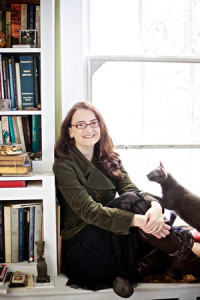 form. She has a B.A. in Anthropology and International Studies with a minor in German from Emory University, and a Masters in Heritage Preservation from Georgia State University. She currently resides in a historic house in the beautiful and quirky town of Mobile, AL.
form. She has a B.A. in Anthropology and International Studies with a minor in German from Emory University, and a Masters in Heritage Preservation from Georgia State University. She currently resides in a historic house in the beautiful and quirky town of Mobile, AL.
Author Links
Website: http://bit.ly/VMFK00
Blog: http://bit.ly/WkQbXG
Join my mailing list: http://bit.ly/1sde3Qi
Paranormal Unbound, the group blog I belong to: http://bit.ly/1sdaIRa
Twitter: http://bit.ly/Se5gQ0
Facebook: http://on.fb.me/VMFT3L
Pinterest: http://bit.ly/1qRhgHQ
September 17, 2014
Becky Lower and Jewelry!!!
Sorry for getting so excited there, but as much as I like to talk about military procedures, politics, and swordplay, I am a girl too. I love jewelry! And I’m thrilled to have Becky Lower back, talking about jewelry of the mid-nineteenth century. Here’s some fun music to enjoy while reading through the post. And now, here’s Becky!
Jewelry and Chatelaines
Historical romances, especially those that focus on fancy dress balls as part of courting rituals, often contain references to the jewels that adorn the necks and earlobes of the lovely debutantes. But what about everyday jewelry in the 1850s?
My latest novel, The Duplicitous Debutante, features a young New York woman who poses as a working class woman, a secretary to a famous author, when the book opens. She would have been someone who needed to keep an eye on the time as she took care of business. I had seen brooches that were also timepieces from this period, but thought they’d be too awkward for her to glimpse at when she was walking, or in a meeting.
My search led me to the discovery of the chatelaine, a decorative belt hook or chain worn at the waist. Chatelaines often signified a woman’s standing in the house, as the woman in charge would have keys to many desks, chests of drawers, food hampers, pantries, storage contain ers and other locked cabinets within a household. She would have the ultimate authority on who would gain access to the various household items under lock and key. The chatelaine holding the keys to the house would pass from mother to the wife of the eldest son, upon her demise. Younger women and daughters would often create their own chatelaines without any keys, from which they hung items of sentimental value.
ers and other locked cabinets within a household. She would have the ultimate authority on who would gain access to the various household items under lock and key. The chatelaine holding the keys to the house would pass from mother to the wife of the eldest son, upon her demise. Younger women and daughters would often create their own chatelaines without any keys, from which they hung items of sentimental value.
Chatelaines were extremely popular among the working class, especially housekeepers who needed to juggle an assortment of keys. Or those women who were seamstresses, as the chatelaine could suspend small scissors, thimbles, needles, and other necessities for working with cloth, and have them all in one convenient place.
Rosemary Fitzpatrick, the heroine in my story, suspends a timepiece from the chain around her waist, so she can be prompt for her meetings with the publisher. She is rarely seen without it during the course of the book, except for when she has her fencing lessons. There is a secret compartment in the back of the timepiece for her to hide a cherished picture or memento. She weaves a braid of her hair mixed with that of the hero and places it in the compartment.
In my travels to the many antique malls I’ve visited in my lifetime, I’ve come across such braids, and always thought they were a bit creepy. But, as I penned my story, it seemed an appropriate keepsake for Rosemary to carry in her chatelaine. As their lives were weaving together, she wove a braid of their hair together. What had once been creepy now became very sentimental. Research tends to make sense out of nonsense.
Ha! I love it, Becky!
Please feel free to scroll over the cover of Becky’s latest release to take you to a bookstore.

